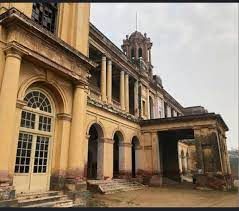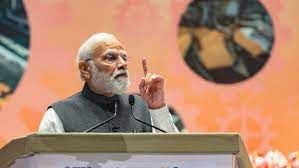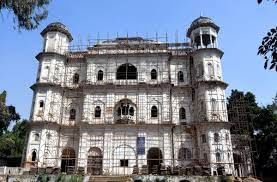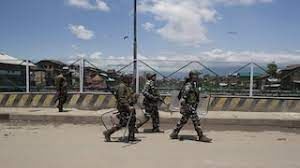UPSC Daily Current Affairs- 6th November 2023 | Current Affairs & Hindu Analysis: Daily, Weekly & Monthly PDF Download
GS-I
Mubarak Manzil Palace of Malerkotla Awaits Restoration
Subject: Art and Culture

Why in News?
Hidden amidst the ruins of Punjab’s Malerkotla town lies the 19th-century Mubarak Manzil Palace, a poignant symbol of the state’s indifference towards its rich heritage.
- Beyond its architectural significance, this palace holds a deep cultural and emotional connection for both Sikhs and Muslims alike.
- However, despite its historical value, the restoration of this magnificent structure has languished in bureaucratic inertia.
About Mubarak Manzil Palace
- Historical Significance: The Mubarak Manzil Palace dates back to the 19th century and stands as a testament to the region’s historical heritage.
- Cultural Significance: Beyond architecture, the palace holds immense cultural and emotional importance for Sikhs and Muslims, serving as a shared legacy.
- Unfulfilled Hope: Begum Munawwar-ul-Nisa, the last surviving member of Malerkotla’s royal family, passed away recently, with her desire to witness the palace’s restoration remaining unfulfilled.
Delayed Restoration Efforts
- Congress Government’s Approval: In 2021, the previous Congress government granted approval for the acquisition and preservation of the palace, kindling hopes for its revival.
- Family Disputes and Financial Constraints: The palace had fallen into disrepair due to family disputes and financial limitations. Begum Nisa, after resolving the disputes, appealed to the State government to take over and restore the palace.
- Unfulfilled Promises: Although Begum Nisa and her family entrusted 29 rooms of the palace to the government’s care, the restoration work has yet to commence. Despite expert assessments in 2022, progress has been stalled, leaving the heritage in disrepair.
Cultural Significance
- Guru Gobind Singh’s Blessing: Malerkotla holds a significant place in Sikh history as it was Nawab Sher Mohammed Khan who protested against the execution of Guru Gobind Singh’s younger sons, Sahibzada Zorawar Singh and Sahibzada Fateh Singh, in 1705. Guru Gobind Singh blessed the town to live in peace.
- Sikh Reverence: Sikhs deeply respect Malerkotla’s royal family for their historical role. The restoration of the palace is considered a fitting tribute to their legacy.
Source: The Hindu
India extends free ration scheme for 5 years
Subject: Social Issues

Why in News?
PM Modi has announced an extension of the Pradhan Mantri Garib Kalyan Anna Yojana (PMGKAY) free ration scheme for another five years.
- The scheme was to end in December 2023.
- PMGKAY was introduced in 2020 during Covid-19 pandemic to provide free food grains to beneficiaries under the National Food Security Act, 2013.
- The PM Garib Kalyan Ann Yojana (PMGKAY) scheme was to end this December.
Pradhan Mantri Garib Kalyan Anna Yojana (PM-GKAY)
- About
- PM-GKAY is a food security welfare scheme announced by the Central Government in March 2020, during the Covid-19 pandemic.
- It is a part of Pradhan Mantri Garib Kalyan Package (PMGKP) to help the poor fight the battle against Covid-19.
- Objective:
- To feed the poorest citizens of India by providing grain through the Public Distribution System, to all the priority households (ration card holders and those identified by the Antyodaya Anna Yojana scheme).
- Launched in 2000, Antyodaya Anna Yojana is a Centrally Sponsored Scheme to provide highly subsidised food to millions of the poorest families.
- Entitlement
- The eligible ration cardholders under NFSA 2013 were entitled to 5 kg free wheat/rice per person per month.
- This was in addition to the 5 kg food grains already provided to the beneficiaries under the National Food Security Act, 2013.
- Implementing Agency:
- Department of Food and Public Distribution, Ministry of Consumer Affairs, Food and Public Distribution.
- Merger of PM-GKAY and NFSA
- In December 2022, the Government amalgamated PMGKAY with NFSA.
- It also decided to extend the scheme for one year till December 2023.
- After the merger, the entire quantity of 5 kg and 35 kg under the NFSA was made available free of cost.
- With this, India has a Central food security legislation which gives the poor a ‘right’ to receive 5 kg foodgrains free of cost.
- Earlier, beneficiaries paid a small price of Rs 3 per kg for rice and Rs 2 per kg for wheat.
- Achievements
- The NFSA covers about 20 Crore families, or a total 81.35 crore beneficiaries, who account for two-thirds of population – 50% urban and 75% rural.
- Since the scheme was introduced in 2020, the government has allocated 1,118 lakh metric tonnes of foodgrains from its central procurement pool at a cost of Rs 3.9 lakh crore.
National Food Security Act (NFSA):
- The NFSA, 2013 was notified to provide for food and nutritional security, by ensuring access to adequate quantity of quality food at affordable prices to people to live a life with dignity.
- It provides a legal right to persons belonging to “eligible households” to receive food grains at subsidised price/central issue prices under the under Targeted Public Distribution System (TPDS).
- State governments are tasked with identifying Antyodaya Anna Yojana (AAY - poorest of the poor) and priority households (PHH) beneficiaries within the TPDS-covered population.
- Every person in the PHH category receives 5 kg of food grains per month at - rice at Rs 3/kg, wheat at Rs 2/kg and coarse grain at Re 1/kg.
- Each Antyodaya Anna Yojana (AAY) household gets Rs 35 kg of food grains per month.
- The Act covers up to 75% of the rural population and up to 50% of the urban population for receiving subsidised food grains (overall 67% of the total population).
Source: The Hindu
‘Enemy Property’ Butler Palace to turn into a tourist haven
Subject: Art and Culture

Why in News?
Lucknow’s iconic Butler Palace, an Enemy Property on the banks of the Gomti River, is set to undergo a remarkable transformation after decades of abandonment and obscurity.
About Butler Palace
- Official Residence: Butler Palace was originally commissioned in 1915 as the official residence of the Avadh Commissioner, Harcourt Butler.
- Ownership by the Raja: It later came under the ownership of the rajas of Mahmudabad, a family with roots tracing back to the 13th century and a history of allegiance to the Mughals.
- Partition and Dispute: After India’s partition, Raja Mohammed Amir Ahmad Khan migrated to Pakistan, while his son, Mohammad Amir Mohammad Khan, stayed in India. Legal disputes over properties, including Butler Palace, ensued.
Genesis of Enemy Property
- Post-War Migration: The origins of enemy property can be traced back to the aftermath of the India-Pakistan wars in 1965 and 1971, which led to the migration of people from India to Pakistan.
- Defence of India Rules: Framed under The Defence of India Act, 1962, these rules empowered the Indian government to assume control of properties and companies owned by individuals opting for Pakistani nationality.
- Custodian of Enemy Property: The central government vested these “enemy properties” in the Custodian of Enemy Property for India (CEPI).
- Similar Instances: A parallel situation emerged concerning property left behind by individuals who relocated to China after the 1962 Sino-Indian war.
- Tashkent Declaration: A pivotal development occurred with the Tashkent Declaration in 1966, where India and Pakistan agreed to discuss the return of properties and assets seized by either side during the conflicts.
- Pakistan’s Disposition: Notably, the Government of Pakistan disposed of all such properties within its territory in 1971.
Legal Framework for Handling Enemy Property
- Enemy Property Act, 1968: Enacted in 1968, this legislation established the continuous vesting of enemy property in the Custodian of Enemy Property for India (CEPI) under the Home Ministry.
- Scope of Properties: The CEPI, acting on behalf of the central government, oversees a range of enemy properties spread across multiple states. This includes both immovable and movable assets, such as shares and gold.
- Amendment in 2017: Parliament passed The Enemy Property (Amendment and Validation) Bill, 2016, which introduced amendments to The Enemy Property Act, 1968, and The Public Premises (Eviction of Unauthorised Occupants) Act, 1971.
Scale and Geographic Distribution
- Vast Inventory: India currently hosts a significant inventory of 12,611 enemy properties, collectively estimated to be worth over ₹1 lakh crore.
- Revenue Generation: The government has generated revenue exceeding ₹3,400 crore by disposing of enemy properties, predominantly involving movable assets like shares and gold.
- Immovable Properties: Interestingly, no immovable enemy properties have been sold to date.
- Origin Breakdown: Out of the 12,611 properties under CEPI’s purview, 12,485 were associated with Pakistani nationals, while 126 were linked to Chinese citizens.
- Regional Distribution: Uttar Pradesh leads with the highest number of enemy properties (6,255), followed by states like West Bengal, Delhi, Goa, Maharashtra, and others. Notably, several states across India have a share of enemy properties, underscoring the broad geographical scope.
Source: The Hindu
GS-II
Cinematograph (Amendment) Bill, 2023
Subject: Polity

Why in News?
In order to curb film piracy, the Union government has appointed nodal officers to order taking down pirated content from digital platforms.
What is Piracy?
- Piracy refers to the unauthorized duplication of copyrighted content that is then sold at substantially lower prices in the 'grey' market.
- The ease of access to technology has meant that over the years, piracy has become more rampant.
- For example, CD writers are available off the shelf at very low prices, making movies/music piracy a simple affair.
Need for a Legislation on Piracy:
- Currently, Cinematograph Act of 1952 is the only legislation in India that guides certification of films for public exhibition.
- The provisions of the legislation are applicable to films released in Indian theatres, which are regulated by the Central Board of Film Certification (CBFC).
- There has been a major jump worldwide in consumption of pirated content over the last few years.
- A recent report has pointed out that India ranked third globally for consuming pirated content in 2021.
- The current Cinematograph Act of 1952 does not have provisions to check video piracy and has limited age-based categories for certification of films.
- It had been largely rendered redundant with the growth of the OTT industry and the content produced by the platforms every year.
- OTT content is governed by the Information Technology (Intermediary Guidelines and Digital Media Ethics Code) Rules, which were released in 2021.
- Over the last few years, the government made multiple attempts to amend the existing Cinematograph Act.
- An expert committee under Justice Mukul Mudgal was set up in 2013 to examine the law.
- A second panel was subsequently constituted under filmmaker Shyam Benegal in 2016 to devise guidelines for certification under the Act.
Cinematograph (Amendment) Bill, 2023:
- The Cinematograph (Amendment) Bill, 2023 amends the Cinematograph Act, 1952.
- The Act constitutes the Board of Film Certification for certifying films for exhibition.
- Such certifications may be subject to modifications/deletions. The Board may also refuse the exhibition of a films.
- Key Features of the Cinematograph (Amendment) Bill, 2023:
- Additional Certificate Categories:
- The Bill adds certain additional certificate categories based on age.
- Also, the Bill provides for separate certificate for television/other media.
- Unauthorized recording and exhibition to be punishable:
- The Bill prohibits carrying out or abetting: (i) the unauthorized recording and (ii) unauthorized exhibition of films.
- The above offences will be punishable with: (i) imprisonment between three months and three years, and (ii) a fine between three lakh rupees and 5% of the audited gross production cost.
- Certificates to be perpetually valid:
- Under the Act, the certificate issued by the Board is valid for 10 years.
- The Bill provides that the certificates will be perpetually valid.
- Revisional powers of the Central government:
- The Act empowers the central government to examine and make orders in relation to films that have been certified or are pending certification.
- The Board is required to dispose matters in conformance to the order.
- The Bill removes this power of the central government.
- Additional Certificate Categories:
News Summary:
- In a bid to curb film piracy, the Information and Broadcasting Ministry has appointed nodal officers authorized to direct the blocking or taking down of any website, app or weblink carrying pirated film content.
- The nodal officers are from the Ministry and the Central Board of Film Certification (CBFC). The action has been taken under the recently amended Cinematograph Act.
- The content creator spends a lot of time and energy making good content; people who are involved in the piracy take away that content and exhibit it in the halls and on online platforms.
- The annual loss to the industry is about ₹20,000 crore to ₹25,000 crore.
- Till now, there was no institutional mechanism to directly act against pirated film content, except for legal proceedings under the Copyright Act and the Indian Penal Code.
- An original copyright holder or any person authorized by them can apply to the nodal officer to get the pirated content taken down.
- After receiving directions from the nodal officer under the law, a digital platform must remove such internet links hosting pirated content within 48 hours.
Source: Indian Express
A leaf out of New Zealand’s voting system
Subject: International Relations

Why in News?
The article explores split voting trends in Odisha and the mixed member proportional (MMP) system in New Zealand. It highlights the benefits of MMP, such as local accountability and improved representation, suggesting that a similar system could address concerns in India’s electoral framework, allowing for nuanced and diverse choices in a mature democracy.
What is mixed member proportional (MMP) system?
- The Mixed Member Proportional (MMP) system is a voting method where voters have two choices. First, they pick their preferred political party, indicating their overall preference for the Parliament’s composition.
- Second, they choose a local representative from their specific area. This system aims to ensure a fair and balanced representation in the Parliament by combining both local and overall preferences of the voters.
Key Terms:
- Split Voting: Voters choosing different parties for different elections.
- MMP System: Mixed member proportional system used in New Zealand.
- Tactical Voting: Supporting a party strategically rather than based on genuine preferences.
- Compulsive Voting: Hesitation to vote outside preferred party or perceived winnable contenders.
- Nuanced Choices: Distinguishing between candidate and party preferences for a mature democracy.
- Switch Seats: Constituencies where voters pick a candidate from one party but give their party vote to another.
Key Data and Facts for mains value addition
- Odisha 2019 Elections: BJD led in Lok Sabha votes in 88 out of 146 Assembly Constituencies but won 113 out of 146 in Assembly votes, showcasing split voting.
- New Zealand MMP System: In the 2020 Auckland Central parliamentary election, 31.86% of votes were split votes, and 13 “switch seats” were created.
Key Highlights:
- Split Voting in Odisha: Despite socio-economic differences, Odisha exhibits split voting, where voters choose different parties for Lok Sabha and State Assembly elections.
- MMP System in New Zealand: New Zealand uses the mixed member proportional (MMP) system, allowing voters to cast separate votes for a party and a local MP. This results in diverse and mindful voting patterns.
- Benefits of MMP: The MMP system provides local accountability, policy focus, improved representation for various groups, enhanced democracy, flexibility, and lower entry barriers for young politicians.
Advantages of the Mixed Member Proportional (MMP) electoral system:
- Local and Overall Representation: MMP allows voters to choose both a local representative and a preferred political party, ensuring representation at both local and national levels.
- Proportional Representation: It provides a more accurate reflection of the public’s overall preferences by allocating seats in proportion to the parties’ share of the total vote.
- Flexibility and Voter Choice: Voters have the flexibility to support a party they believe in while also selecting a local representative, promoting a diverse range of political choices.
- Reduced Wasted Votes: Fewer votes go to waste as the proportional representation aspect ensures that even parties with smaller followings receive some representation in the legislature.
- Coalition Building: Encourages coalition governments, fostering cooperation and compromise among different parties for effective governance.
Challenges and concerns
- Tactical Voting: Critics worry that MMP might encourage tactical voting, where voters strategically support a party not because it aligns with their true preferences, but to influence the outcome.
- Example: In MMP, a voter might vote for a larger party, not because they truly support it, but to prevent another party they strongly dislike from gaining power. This strategic voting can distort the true reflection of public preferences.
Limited Accountability in MMP:
- Explanation: Some argue that the MMP system might lead to less direct accountability of elected representatives to their local constituents, as they also rely on a party list for their position.
- Example: If a local representative is assured a seat through the party list, they might be less motivated to address the specific concerns of their local voters, as their position is not solely dependent on local support.
Complexity for Voters:
- Explanation: The two-vote system in MMP may be confusing for some voters, leading to potential errors or unintentional consequences in the voting process.
- Example: Voters may find it challenging to understand the strategic implications of splitting their votes between a party and a local candidate, leading to unintended outcomes that don’t align with their true preferences.
Possibility of Minority Governments:
- Explanation: MMP may result in coalition governments, and some argue that this can lead to instability and challenges in decision-making.
- Example: If no party gains a clear majority, parties may need to form coalitions to govern. While this ensures representation, it may also lead to compromises and difficulties in implementing policies.
Way Forward:
- Consideration of Split Voting in India: The article suggests that a split voting system in India could address concerns about compulsive voting, allowing voters to choose candidates based on merit while ensuring party preferences impact legislative composition.
- Democracy Enhancement: Emphasizes the essence of democracy in offering diverse and nuanced choices, with split voting seen as a way to achieve this.
- Public Awareness and Education: Emphasize the importance of public awareness and education campaigns to familiarize voters with the MMP system. This includes explaining the two-vote process and the impact of split voting, ensuring an informed electorate.
- Continuous Evaluation and Adaptation: Implement a system of continuous evaluation and adaptation to address any challenges or shortcomings in the MMP system. This involves periodically reviewing the system’s functioning and making necessary adjustments to enhance its effectiveness.
Source: The Hindu
GS-III
H. Pylori Detection and Drug-Resistance Identification
Subject: Science

Why in News?
Indian researchers have developed a groundbreaking two-step PCR-based assay for detecting Helicobacter pylori (H. pylori) infection, determining clarithromycin resistance, and distinguishing drug-sensitive strains.
- This molecular diagnostic tool reduces the detection time from weeks to just six-seven hours and exhibits remarkable accuracy, boasting 100% sensitivity and specificity.
About H. Pylori Detection
- Helicobacter pylori, often abbreviated as H. pylori, is a type of bacteria that can infect the stomach and the upper part of the small intestine.
- It is a common bacterial infection associated with various gastrointestinal conditions, including gastritis (inflammation of the stomach lining) and peptic ulcers (sores or lesions in the lining of the stomach or the duodenum, which is the first part of the small intestine).
Why discuss this?
- Increasing Resistance: India faces a growing challenge of clarithromycin-resistant H. pylori strains, resulting in decreased treatment efficacy.
- Asymptomatic Infections: While most H. pylori infections are asymptomatic, 10–15% of cases lead to peptic ulcer disorders or stomach cancer.
- Prevalence in India: H. pylori infections affect 60-70% of the Indian population, acquired in childhood and persisting if not treated.
- Gastric Cancer Risk: H. pylori infection is a significant risk factor for gastric cancer.
Understanding Drug Resistance Mechanism in H. Pylori
- Genome Sequencing: Researchers identified a point mutation (A to G mutation at position 2143) in the 23S ribosomal RNA (rRNA) gene as the cause of clarithromycin resistance.
- Confirmation: They isolated and transferred the 617 base pairs containing the mutation to drug-sensitive bacteria, which became resistant, confirming the mutation’s role.
- Published Findings: The study’s results were published in the journal Gut Pathogens.
- Exploring Binding Affinity: Bioinformatics analysis revealed that drug-resistant strains had weaker binding affinity to clarithromycin compared to drug-sensitive strains.
- Impact of Weak Binding: Weaker binding limits the drug’s penetration into bacteria, rendering it ineffective against resistant strains.
Development of the PCR-Based Assay
- Biopsy Samples: The DNA template used for the assay was prepared by amplifying a small segment containing the point mutation directly from biopsy samples.
- Validation: DNA templates from cultured bacteria were compared with those from biopsy samples to validate their accuracy.
- Two-Step PCR: The assay employs a two-step PCR approach to detect H. pylori infection and differentiate resistant from sensitive isolates.
- Allele-Specific Primers: Resistant-specific and sensitive-specific primers exploit the point mutation for selective amplification.
- High Accuracy: Evaluation against conventional methods and sequencing analysis demonstrated 100% sensitivity and specificity.
Source: The Hindu
India to bring in a National Security Strategy
Subject: Defence

Why in News?
After years of deliberations in the military and strategic community, India has kickstarted the process of bringing in a National Security Strategy.
- The National Security Council Secretariat (NSCS) is in the process of collating inputs from several Central ministries and departments.
- This is the first time that India would come out with such a strategy.
The National Security Council Secretariat (NSCS):
- Background:
- The National Security Council (NSC) of India is an executive government agency established in 1998 and tasked with advising the Prime Minister's Office on matters of national security and strategic interest.
- The NSC is the apex body of the 3-tiered structure of the national security management system in India.
- The 3-tiers are the Strategic Policy Group, the National Security Advisory Board and a secretariat from the Joint Intelligence Committee (JIC).
- The National Security Advisor (NSA) presides over the NSC.
- NSA is also the primary advisor to the prime minister.
- About National Security Council Secretariat (NSCS) –
- NSCS is the apex agency looking into the political, economic, energy and strategic security concerns of India.
- The NSCS has four verticals:
- Strategic Planning;
- Internal Affairs;
- Intelligence and Technology;
- Military
- National Cyber Security Coordinator (NCSC) works under NSCS and coordinates with different agencies at the national level for cyber security matters.
National Security Strategy
- A National Security Strategy document outlines the country’s security objectives, and the ways to be adopted to achieve these.
- It defines traditional, non-traditional threats and opportunities while introducing accountability of agencies tasked with the implementation of such responsibilities.
- In a nutshell, a national security strategy would guide the military as well as critical defence and security reforms with strategic implications.
- It will provide a holistic view of the overall national security, the threats and the roadmap to address them.
Contours of the strategy being drafted by India
- The exact contours of the strategy being drafted is not known.
- However, it will likely include the entire range of newer challenges and modern threats facing India, including non-traditional ones such as:
- financial and economic security,
- food and energy security,
- information warfare,
- vulnerabilities in India’s critical information infrastructure, as well as those associated with supply chains and environment.
Countries having a National Security Strategy
- Most developed countries with an advanced military and security infrastructure have a National Security Strategy in place, updated from time to time.
- The US, the UK and Russia have published national security strategies.
- China also has such a strategy in place, called the Comprehensive National Security, which is closely tied to its governance structure.
- Pakistan, too, has brought out a National Security Policy 2022-2026, underlining its national security objectives and priority areas.
India’s need for a National Security Strategy
- Complex nature of various threats
- Given the complex nature of the various traditional and non-traditional threats, urgency was felt to draft a national security strategy.
- This becomes significant especially when rising geopolitical tensions have given way to uncertainties.
- No concrete document to guide the military forces
- As per security experts, the only political direction to the Armed Forces in existence is Raksha Mantri’s operational Directive of 2009.
- It is now dated and hence needs to be revised.
- Some experts have also highlighted that major military reforms should ideally flow from a national security strategy.
- Without such a well-defined strategy, military reforms would be like putting the cart before the horse.
Why did India never have a national security strategy?
- In the past, three attempts were made to come out with a national security strategy, but there was hesitation at the political level.
- As per security experts, it could have been because of the accountability it would bring in defence management for the government.
- There have been varying views in the strategic community in the past over why India has not brought out a national security strategy.
- This varies from lack of a cohesive, whole-of-government effort, to the government deliberately not making public its national security objectives.
Source: The Hindu
|
38 videos|5288 docs|1117 tests
|





















